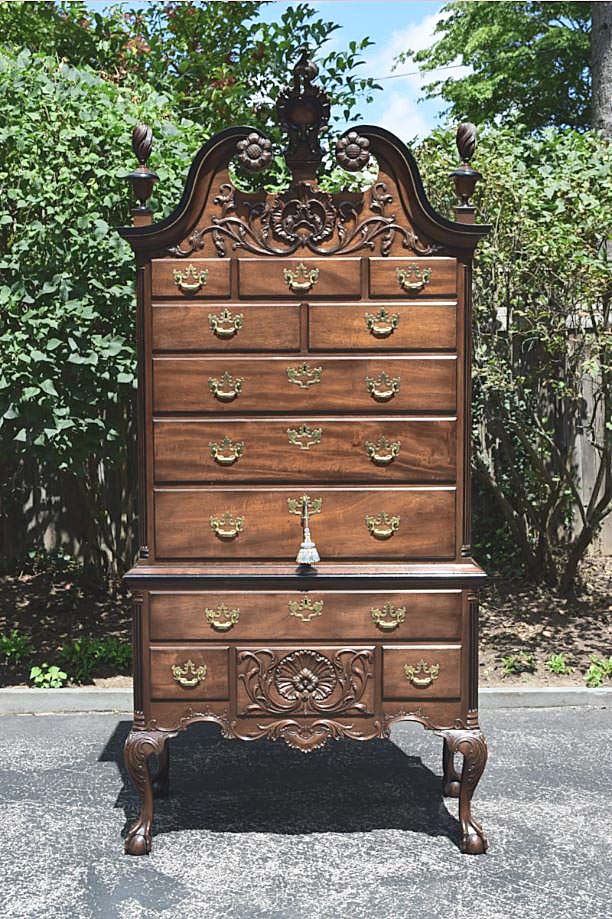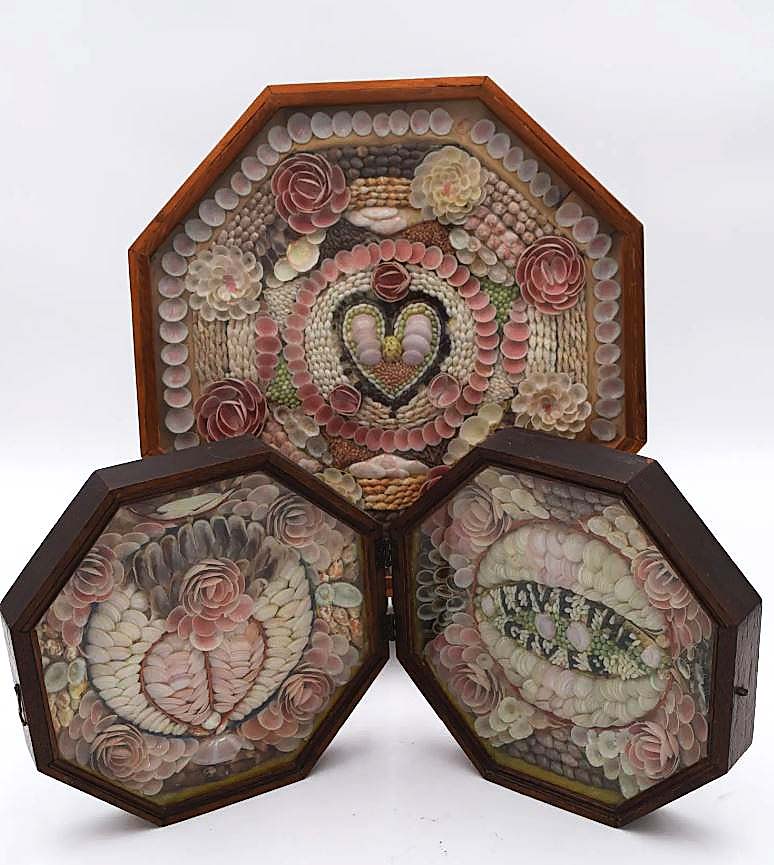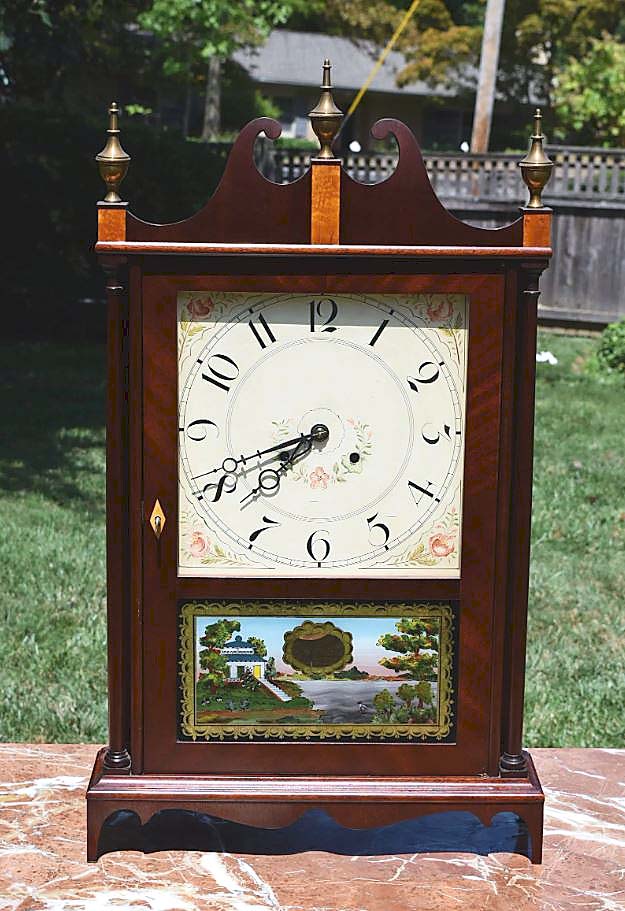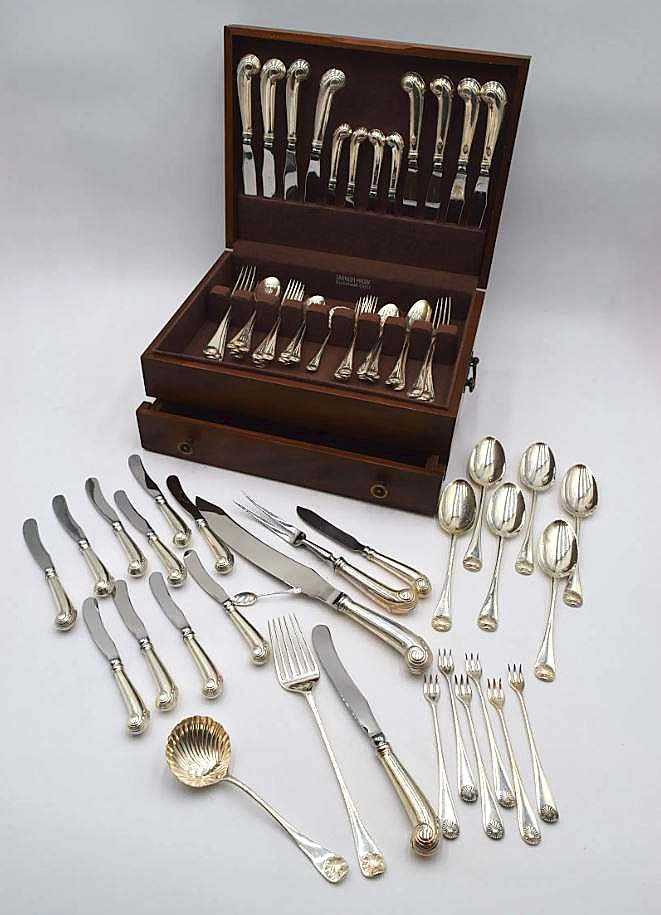
Kittinger made just 12 copies of this high chest after an original example in the Mabel Brady Garvan Collection at the Yale University Art Gallery. Estimated at $8/10,000, it sold for $22,500.
Review by Madelia Hickman Ring
ENKINTOWN, PENN. — Over the past several years, the auction market for antique period furniture — those being made when a particular aesthetic was first introduced, typically in the Seventeenth, Eighteenth or Nineteenth Centuries — has been on a roller coaster of sorts. When old reproductions are included in auctions and bring prices high enough to rival the earlier antique counterparts, the discussion occasionally leads to negative comparisons, suggesting a poor market when “original” pieces are not sufficiently revered (and valued) over “copies.”
It is rare to see an auction packed with high-level reproductions, but Stenella Auctions had one such sale, presenting on October 22 and 23, 871 lots from the collection of the late George E. Harrison III, and his late wife, Linda. The couple, whose business Americana Interiors showcased high-end reproductions and bench-made copies, were known for their expertise in so-called “second period” objects — and filled their home as well as those of their clients with them. Stenella’s unreserved auction celebrated them for what they were and the collection was well received. The sale was the firm’s debut auction on LiveAuctioneers and about 90 percent of the lots found new homes.
Kasey Bradley, Stenella’s marketing director, said the sale was “very successful and we’re very happy. It attracted many of our older clients and several of George’s customers, as well as lots of people new to us.”

These three octagonal sailor’s valentines were among the highest prices achieved on the second day of the auction. Bidders loved them, with one persistent buyer winning the group for $3,000 ($200/400).
Leading the day at $22,500 was a limited edition reproduction of a Philadelphia Chippendale high chest attributed to Thomas Affleck that was made by Kittinger. Just 12 copies were reproduced in 1966 after the original, which is now in the Mabel Brady Garvan Collection at the Yale University Art Gallery. Interestingly, a brass plaque affixed to the piece that included the name of the original owner of the reproduction, noted that the reproduction had been “approved by the curator,” though unidentified. It had been estimated at $8/10,000.
Kittinger made 150 copies of a North Shore, Massachusetts, Chippendale bombé chest-on-chest made around 1780 that is presently at Colonial Williamsburg. The example from the Harrison collection was numbered “85” and bore — in addition to a brass plaque on the inside of a drawer — a large printed label that included the signature of the cabinetmaker. The stately piece surpassed its high estimate and sold for $8,750.
A similar label was inside a shelf clock made by Colonial Williamsburg and modeled after one made by Eli Terry, Sr (1772-1852), in Colonial Williamsburg’s collection. A reverse painted panel, brass finials and burl wood inlays embellished the clock, which traded hands for $6,250, more than six times its high estimate. Elmer O. Stennes’ (1911-1975) eglomise girandole banjo clock timed out at $3,500.

Colonial Williamsburg made its own line of reproductions, including this copy of a shelf clock made by Eli Terry, Sr. Estimated $800-$1,000, it timed out at $6,250.
Pieces from Winterthur Museum’s collection also provided inspiration for furniture reproducers, evidenced by Kindel’s copy of a Chippendale block-front desk and bookcase that was made in the 1770s by the Goddard Townsend family of cabinetmakers for the Updyke family. No mention was made as to how many copies Kindel made, but the example stayed within estimate, bringing $4,500.
Forms of many variations were included in the sale. A tall case clock ($5,750), a bombé chest ($3,000), a Queen Anne-style needlepoint chair ($2,750), a Chippendale-style side chair ($2,500), a Chippendale-style pie crust tilt-top tea table ($2,375), a Federal-style drop-leaf table ($2,125) and a Chippendale-style lowboy ($2,000) were all from Kittinger’s Colonial Williamsburg line, as was a set of three Windsor dining chairs, in black paint, of only a handful examples known, which finished at $1,875.
Second period silver, porcelain and other decorative furnishings could also be had. A selection of about 30 stoneware objects — most appearing to be unmarked but with some attributions — was led at $2,500 by an 11¾-inch-tall cobalt-decorated pitcher attributed to Shenfelder of Reading, Penn.
The silver category had a high mark of $2,750, reached by a 78-piece of Stieff sterling silver in the Colonial Williamsburg pattern. It was followed by a Colonial Revival sterling silver inkstand, modeled after one made by Philadelphia silversmith Philip Syng in 1752 and used to sign the Declaration of Independence, topped off at $2,375.

This 78-piece set of Stieff sterling silver flatware, made in the Colonial Williamsburg pattern, achieved $2,750 ($3/4,000).
Trading hands at $1,625 was a Bicentennial Mottahedeh Chinese export-style center bowl with eagle decoration, and $2,250 was enough to win a gold leaf mirror with candle sconces made by Friedman Brothers after one at Colonial Williamsburg.
Period antiques were sprinkled among their later cousins and brought comparable prices. An eglomise girandole banjo clock signed “Elmer O. Stennes, Weymouth, Mass” achieved $3,500, while an Eighteenth Century Chippendale walnut highboy, attributed to Pennsylvania, brought $2,000.
A group of three sailor’s valentines, offered halfway through the second day of the auction, soared to $3,000, just behind the $3,500 achieved by a Marantz 2500 stereophonic receiver that crossed the block towards the end of the auction.
Prices quoted include the buyer’s premium as reported by the auction house.
The John Arnold Bower-designed “Gustav Aberly House” in which Linda and George E. Harrison III resided, in Rydal, Penn., will be auctioned by Stenella Auctions with an opening bid of $500,000. Bidding will close on December 11, for the highest submitted bid.
For additional information, www.stenellaauctions.com or 215-453-8490.
















